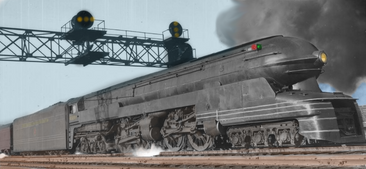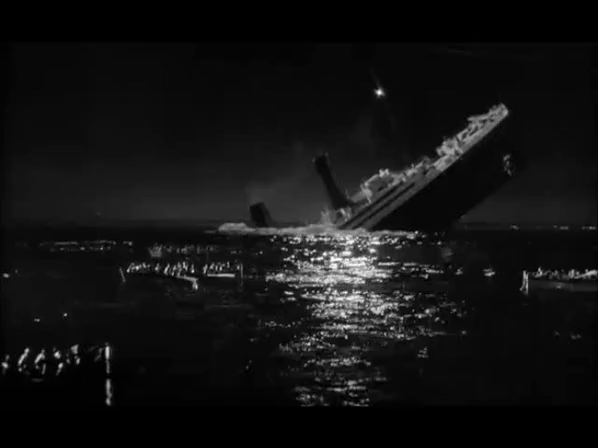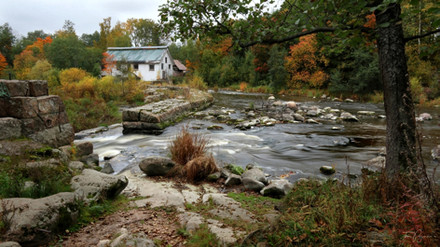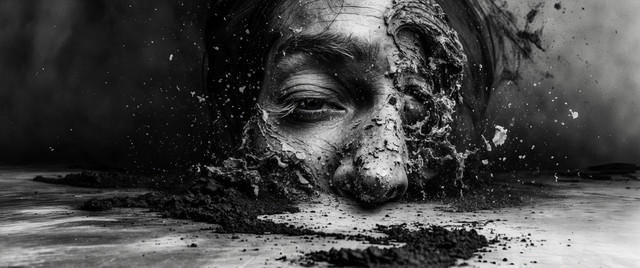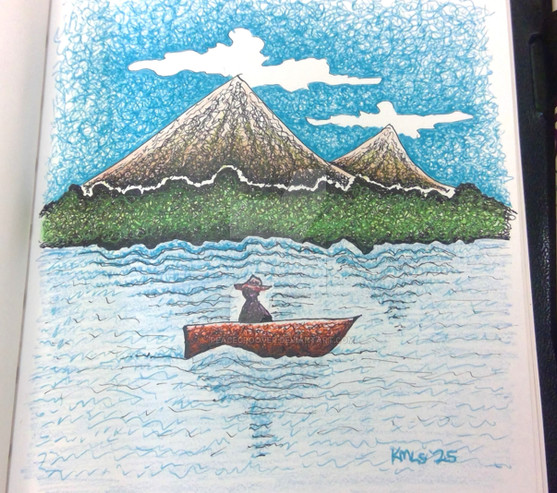HOME | DD
 Engine97 — Bennington Curve
Engine97 — Bennington Curve
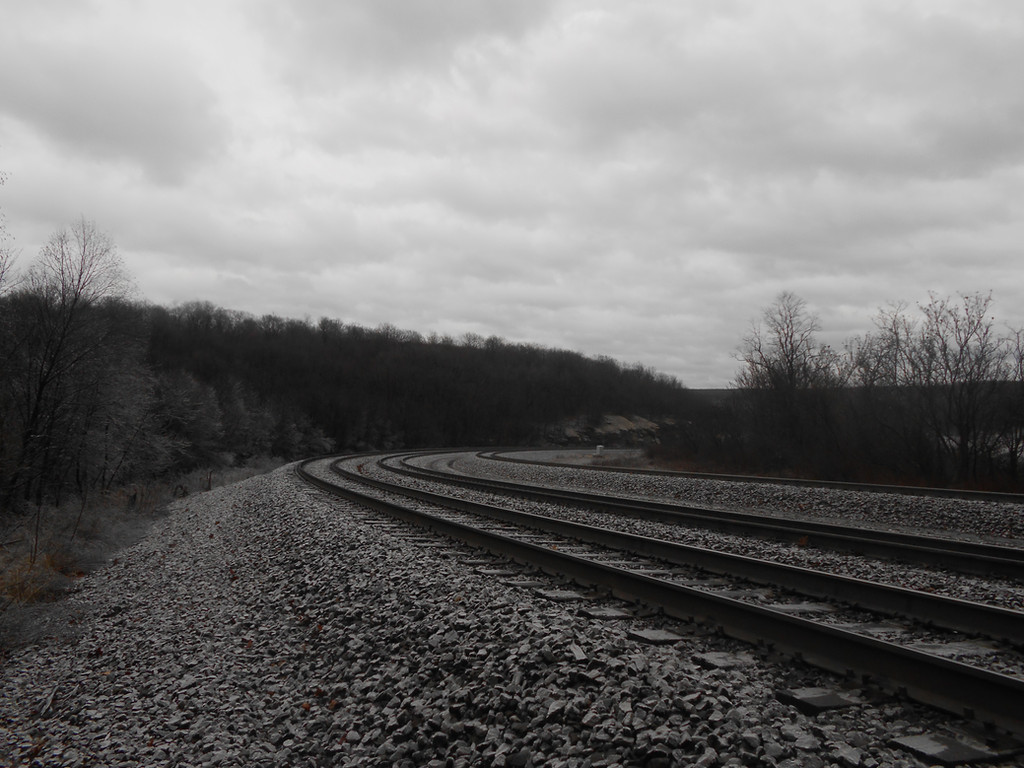
#pennsylvaniarailroad #steamlocomotive #trainwreck
Published: 2015-01-05 02:51:07 +0000 UTC; Views: 1220; Favourites: 19; Downloads: 4
Redirect to original
Description
Were I am standing is where Pennsylvania Railroad K-4s number 422 left the rails, taking with it K-4s 3771 and 11 passenger cars over the embankment and into Gum Tree Hallow . ~
3078
INTERSTATE COMMERCE COMMISSION
WASHINGTON
INVESTIGATION NO. 3078
THE PENNSYLVANIA RAILROAD COMPANY REPORT IN RE ACCIDENT NEAR GALLITZIN, PA., ON FEBRUARY 18, 1947
Inv-3078
SUMMARY
Railroad: Pennsylvania
Date: February 18, 1947
Location: Gallitzin, Pa.
Kind of accident: Derailment
Train involved: Passenger
Train number: 68
Engine numbers: 422-3771
Consist: 14 cars
Speed: In excess of 65 m. p. h.
Operation: Signal indications
Tracks: Four; 8 degrees 30' curve; 1.73 percent descending grade eastward
Weather: Hazy
Time: 3:21 a.m.
Casualties: 24 killed; 138 injured
Cause: Excessive speed on curve
INTERSTATE COMMERCE COMMISSION
INVESTIGATION NO. 3078
IN THE MATTER OF MAKING ACCIDENT INVESTIGATION REPORTS UNDER THE ACCIDENT REPORTS ACT OF MAY 6, 1910.
THE PENNSYLVANIA RAILROAD COMPANY
April 7, l947.
Accident near Gallitzin, Pa., on February 18, 1947, caused by excessive speed on a curve.
REPORT OF THE COMMISSION 1
PATTERSON, Commissioner:
On February 18, 1947, there was a derailment of a passenger train on the Pennsylvania Railroad near Gallitzin, Pa., which resulted in the death of 15 passengers, 6 railway-mail clerks and 3 train-service employees, and the injury of 121 passengers, 4 railway-mail clerks, 7 Pullman employees, 4 dining-car employees and 2 train-service employees. This accident was investigated in conjunction with a representative of the Pennsylvania Public Utility Commission.
Inv. No. 3078 Pennsylvania Railroad Gallitzin, Pa. February 18, 1947
Location of Accident and Method of Operation
This accident occurred on that part of the Pittsburgh Division extending between Pittsburgh and Division Post, near Altoona, Pa., 112.6 miles. In the vicinity of the point of accident this is a four-track line. The main tracks from south to north are designated as No. 1, eastward freight; No. 2, eastward passenger, No. 3, westward freight; and No. 4, westward passenger. Trains moving with the current of traffic on these tracks are operated by automatic block-signal and cab-signal indications. The accident occurred on track No. 2, at a point 103.83 miles east of Pittsburgh and 1.83 miles east of the station at Gallitzin. From the west on track No. 2 there are, in succession, a 1 degree 20' curve to the left 1,965 feet in length, a tangent 1,024 feet, a 0 degree 30' curve to the right 255 feet, a tangent 1,031 feet and an 8 degrees 30' curve to the right 190 feet to the point of derailment and 950 feet eastward. The grade for east-bound trains on track No. 2 varies between 1.42 and 2.36 percent descending throughout a distance of 1.74 miles immediately west of the point of accident, where it is 1.73 percent descending.
On the curve on which the accident occurred, the structure of tract No. 2 consists of 130-pound rail, rolled in 1929, cropped to 35 feet in length, and relaid in August, 1946, on an average of 21 treated hardwood ties to the rail length. It is fully tieplated with double-shoulder tieplates, spiked with 5 spikes per tieplate and provided with 6-hole angle bars and 8 rail anchors per rail length. It is ballasted with crushed stone to a depth of 36 inches. The specified superelevation on the curve was 3-1/2 inches, and the gage varied between 4 feet 8-3/8 inches and 4 feet 8-7/8 inches. At the point of derailment the superelevation was 3-3/8 inches and the gage was 4 feet 8-7/8 inches. The west 250 feet of track on the curve involved is laid in a rock out, the walls of which rise to a maximum height of about 30 feet. The remainder of the track on this curve is laid on a 92-foot fill, the base of which is 370 feet wide.
Semi-automatic signal 50R, governing east-bound movements on track No. 2, is 1,052 feet west of the point of accident. This signal is of the position-light type, and is continuously lighted. A flange-oiling device and the west end of the circuit of a track speed-recording device are located, respectively, 720 feet and 800 feet cast of signal 50R. The circuit of the speed-recording device is 0.2 miles long.
Time-table special instructions read in part as follows:
2419. * * * Engineman of eastward passenger trains will * * * make a running test of the air brakes just before passing over the summit east of AR.
* * *
AR is 2.03 miles west of the point of accident.
Time-table special instructions prescribe the maximum authorized speed for the train involved as 35 miles per hour on the tangent track immediately west of the curve involved and 30 miles per hour on the curve.
Description of Accident
No. 68, an east-bound first-class passenger train, consisted of engines 422 and 3771, of the 4-6-2 type, one baggage-mail car, one passenger-baggage car, one coach, two sleeping cars, one dining car, six sleeping cars, one coach and one baggage-express car, in the order named. The ninth, eleventh and thirteenth cars were of lightweight-stainless-steel construction, and the remainder of the cars were of conventional standard all-steel construction. This train departed from Pittsburgh at 1:05 a.m., 56 minutes late, passed AR, the last open office, at 3:17 a.m., 1 hour 3 minutes late, passed Gallitzin, passed signal 50R, which displayed proceed, and which it was moving on track No. 2 at a speed estimated to have been in excess of 65 miles per hour the engines, the first ten cars and the front truck of the eleventh car were derailed.
The first engine overturned to the left and stopped on its left side, down the embankment and at right angles to the tracks, with the front and 405 feet east of the point of derailment and 104 feet north of the centerline of track No. 2. The cab was demolished, steam pipes within the cab were broken and the left side of the engine was badly damaged. The tender of the first engine stopped upside down, off its trucks, at a point 80 feet north and 27 feet east of the engine and at right angles to it. The tender was badly damaged. The second engine overturned to the left, stopped on its left side and against the first engine, with the front and 401 feet east of the point of derailment and 88 feet north of the centerline of track No. 2. The front-end frames and the cradle casting and tail piece were broken, the cab was demolished, steam pipes within the can were broken and this engine was otherwise badly damaged. The tender of the second engine stopped upside down, off its trucks and at a point 76 feet north and 68 feet east of its engine. This tender was badly damaged. The engine trucks of both engine were torn loose, and stopped near their respective engines. The safety chains of the engine truck assemblies of both engines were broken as a result of the derailment. The first car stopped on its left side and down the embankment, with the front and 425 feet east of the point of derailment and 96 feet north of track No. 2. This car was practically demolished. The second car stopped on its left side, across tracks Nos. 3 and 4 and at an angle of 15 degrees to them, at a point 481 feet east of the point of derailment. This car was badly damaged. The third car stopped with the front end on top of the first car and the rear end on track No. 4. The top of this car was crushed inward to the belt rail, and the car was otherwise badly damaged. The fourth car stopped on its left side and on top of the tender of the first engine. This car was practically demolished. The fifth car stopped upright, about 8 feet west of the second engine and in lien with it. This car was badly damaged. The sixth car stopped on its left side, down the embankment and at an angle of about 45 degrees to the track, with the front and 397 feet east of the point of derailment and 200 feet north of track No. 2. This car was badly damaged. The seventh car stopped upright, on the roadbed and at an angle of about 50 degrees to the tracks, with the front end 304 feet east of the point of derailment and 89 feet north of track No. 2. This car was considerably damaged. The eighth, ninth and tenth cars remained coupled and stopped upright, across tracks Nos. 2, 3 and 4 and at an angle of about 10 degrees to them, with the front of the eighth car 23 feet north of track No. 2 and the rear of the tenth car between tracks Nos. 2 and 3. These cars were more or less damaged.
Engine 422 and 3771 are of the same class and type. The total weight of each engine in working order is 320,000 pounds, distributed as follows: Engine truck, 53,200 pounds; driving wheels, 209,300 pounds; and trailer truck, 57,500 pounds. The specified diameters of the engine-truck wheels, the driving wheels, and the trailer-truck wheels are, respectively, 36, 80 and 50 inches. The rigid wheelbase of each engine is 13 feet 10 inches in length, the total length of the engine wheelbase is 36 feet 2 inches, and the total length of each engine and its tender is 86 feet 11-3/4 inches. The tenders are rectangular in shape and are equipped with two 4-wheel trucks. The capacity of each tender is 43,600 pounds of coal and 13,475 gallons of water. The total weight of each tender loaded is 254,450 pounds. The center of gravity of each engine is 80 inches above the tops of the rails. The center of gravity of each tender, with the calculated amount of fuel and water at the time of the accident, was 61.4 inches above the tops of the rails. The equilibrium, safe and overturning speeds for these engine moving on an 8 degrees 30' curve having a superelevation of 3-1/2 inches are, respectively, 25, 42.9 and 65.1 miles per hour. The equilibrium, safe and overturning speeds of the tenders on the curve are, respectively, 25, 46.2 and 73.2 miles per hour.
The last class repairs of engine 422 were completed on May 3, 1946. The last quarterly and monthly inspection and repairs were completed on February 11, 1947, and the last trip inspection and repairs were completed at Pittsburgh about 6:30 p.m., February 17, 1947. The accumulated mileage since the last class repairs was 55, 641 miles. The last class repairs of engine 3771 were completed March 27, 1946. The last quarterly inspection and repairs were completed on December 20, 1946. The last monthly inspection and repairs were completed on January 28, 1947; and the last trip inspection and repairs were completed at Pittsburgh about 10 p.m., February 17, 1947. The accumulated mileage since the last class repairs was 70,203 miles.
Engines 422 and 3771 are provided with No. 6-ET brake equipment, one 8-1/2 cross-compound air compressor, and an auxiliary emergency valve located on the back of the right side of the cab. The double-heading cock is located in the main-reservoir supply pipe. Each tender is provided with a brake-pipe vent valve to insure the propagation of emergency rate of brake application throughout the train. Single-top air-compressor governors were adjusted to supply main-reservoir pressure of 130 pounds, and the M-3 brake-pipe feed valves were adjusted to supply a brake-pipe pressure of 110 pounds. Of the cars of No. 68, there were equipped with D-22-AR control valves, and the remainder with UC-12-B, control valves.
After the accident, tests of the air-brake systems of the engines of No. 68 disclosed that the automatic and the independent brake valves, the distributing valves, the vent valves, the brake-pipe feed valves and the compressor governors functioned properly. The control valves of each unit of the train functioned properly. Because of damage to the equipment as a result of the derailment the brake-cylinder piston travel of the first to eleventh cars, inclusive, could not be measured. The brake-cylinder piston-travel of the rear three cars was in conformity with the requirements of the carrier.
The fireman of the first engine, and the engineer and the fireman of the second engine were killed. The engineer of the first engine and the front brakeman were injured.
The weather was hazy at the time of the accident, which occurred about 3:21 a.m.
Discussion
No. 68 was moving on an 8 degrees 30' curve to the right when the derailment occurred. Both engines and their tenders overturned to the left and stopped about 400 feet east of the point of derailment and at the foot of a 92-foot fill. The maximum authorized speed for this train was 35 miles per hour on the tangent track immediately west of this curve, and on the curve it was 30 miles per hour.
As No. 68 was approaching the point where the accident occurred, the conductor was in the eighth car, the front brakeman was in the sixth car, and the flagman was in the thirteenth car. Prior to the accident the cars had been riding smoothly. The conductor and the flagman said that a service application of the brakes was made when the train was in the immediate vicinity of the summit of the grade, 1.74 miles west of the point of accident, in accordance with special instructions which require that a running test of the train air-brake system be made in that vicinity, then the brake were released. Soon afterward the brakes were again applied in service application, and they thought that this application was not released. The front brakeman said that he did not observe any application of the brakes in this vicinity prior to the time the brakes became applied in emergency when the derailment occurred. The members of the train crew though the speed of their train was about 30 miles per hour when the derailment occurred.
The brakes of this train had been tested and had functioned properly en route. No. 68 did not stop at any point between Pittsburgh and the point where the derailment occurred. A car inspector, who was in the vicinity of he tower at AR, said that he observed the equipment of No. 68 when this train passed that point, and there was no indication of any defective condition of the engines or the cars. The enginemen of two engines, which were standing at the rear end of a west-bound freight train on track No. 3 at a point about 1,900 feet west of the point of accident, said that when No. 68 passed the location of their engine the speed of that train was at least 45 or 50 miles per hour. The fireman of one of these engines said that the headlight of the first engine of No. 68 was lighted, and he observed sparks flying from brake shoes at intermittent locations throughout the cars of the train, but no sparks appeared at the brake-shoe locations on the engines or the tenders. The engineer of the first engine of No. 68 said that he estimated the speed of the train as about 25 miles per hour when his engine was in the vicinity of the apex of the grade, and he made a running test of the brakes in this vicinity. Then, after this brake application was released, he placed the throttle lever in closed position. When his engine reached a point about 3,000 feet eastward the spaced was about 30 miles per hour, and he made an 8-pound brake-pipe reduction. Additional brake-pipe reductions totaling 8-pounds were made throughout a distance of about 1,500 feet immediately eastward. This brake application was not released, and he estimated the speed as about 22 miles per hour when his engine reached a point about 2,500 feet west of the west end of the curve. At this point he moved the automatic brake valve to release position momentarily, then placed the valve in lap position to effect a graduated release of the train brakes. He estimated the speed as about 31 miles per hour when his engine was in the vicinity of signal 50R, and he made a 2-pound brake-pipe reduction. Throughout this territory the brakes of the engines and the tenders were not applied. He thought this action was sufficient to control the speed in accordance with the authority speed for the curve. He said that as his engine entered the curve the throttle lever became unlatched and moved on the quadrant to about half-open position. At that time he was looking forward with his head outside the cab window and when he heard the engine exhausting steam he immediately moved the throttle lever to closed position. The throttle lever was in open position a few seconds only, and he did not think that slack action of any consequence resulted. He was not aware of anything being wrong until the engine overturned, then he moved the brake valve to emergency position. The engineer of the second engine, and the fireman of both engines were killed.
The road foreman of engines said that, to control properly the speed of a train comparable in weight, braking ratios and consist to that of No. 68 on the day of the accident, it is customary to make a running test of the air brakes between AR and the apex of the grade east of AR. Upon noting the effectiveness of the train air-brake system, the brakes are released and the throttle is closed. Then another brake-pipe reduction of 10 or l5 pounds is made to control the speed on the 2.36 percent portion of the descending grade and further brake-pipe reductions are made as required. This action results in the reduction of speed to 20 or 25 miles per hour before the engine enters the curve involved, then the brakes are released so that the engines and cars may move freely on the curve. A speed-recording device, which is controlled by track circuits, records the speed of trains on the curve. Careful check is made of these recordings, and disciplinary action is taken in instances when the maximum authorized speed is exceeded. A check of train movements during a period of 30 days prior to the accident disclosed that in one instance a train moved on the curve at a speed of 31.3 miles per hour, but the average speed of trains during this period was about 20 miles per hour. A check of the performance of the engineer who had charge of the first engine of No. 68 during the trip in question disclosed that, during the 6-month period prior to the accident, in three instances only the speed throughout the curve was 30 miles per hour and on the remainder of the trips the speed ranged between 15 and 28 miles per hour. On the trip involved, No. 68 had traversed a distance of only 252 feet of the speed-recorder circuit, therefore, the device did not record the speed of this train. The engines involved were not equipped with speedometers. The road foreman of engines said that the observation made by the fireman of the engine standing on track No. 3 that brake-shoe sparks appeared intermittently only throughout the cars of No. 68 and that no sparks appeared at brake-shoe locations on the engines and the tenders indicated that a brake application had been partially released at that time, and that such action would be most unusual.
Examination of the engines of No. 68 and their tenders disclosed no condition which could have contributed to the cause of the derailment. The engine-truck assemblies, and the driving-wheel and trailer-truck assemblies were in good condition. The wheels were tight on the axles and the tires were tight on the wheel centers. Measurements of the tires, the wheels and the lateral motion were within the specified limits. The driving-box shoes and wedges, and the chafing plates between the engines and the tenders were well lubricated. The spring arrangements were maintained in good alinement, the equalizers and hangers were properly maintained, and there was no indication of unequal distribution of weight. The tender trucks were well maintained and there was no indication of improper side-bearing clearance. The trucks of both tenders were torn loose and the right, front wheel of one of these trucks had been forced inward on its axle a distance of 1-5/16 inches, as a result of its having been struck by derailed equipment. The lateral-resistance swing-motion of the engine trucks and the tender trucks, and the center-plate castings of these trucks were in good condition and well lubricated. There was no mark of derailment on the flanges, treads, or side- surfaces of any wheel of either engine. The throttle levers were latched in closed position, the reverse levers were in position for forward motion, and the independent and the automatic brake valves on both engines were in running position. Resistance tests indicated that these valves had not been moved as a result of the derailment. The double-heading cock on the first engine was in open position and the double-heading cock on the second engine was in closed position. The auxiliary emergency valves, located in the right gangway of each engine, were in closed position. The injectors on the right side of each engine were in operating position.
Examination of track No. 2 throughout a distance of one mile immediately west of the point of accident disclosed that the surface, gage and alinement were well maintained for the maximum authorized speed. There was no mark on the track structure indicating dragging equipment, or any obstruction having been on the track. Beginning at the west end of the curve the superelevation increased 1/2 inch in each 31 feet throughout a distance of 115 feet to the point of full curvature, and the curvature increased proportionately throughout this distance. Measurements of the cross-level and the gage of the track taken at stations 15.5 feet apart disclosed that the maximum variation was 1/8-inch. The specified curvature was 8 degrees 30', and the specified superelevation was 3-1/2 inches. The curvature at the point of derailment was 8 degrees 31', the superelevation was 3-3/8 inches, and the gage was 4 feet 8-7/8 inches. The track on the curve was last resurfaced during November, 1946, and was last gaged on February 12, 1947. It was last inspected by members of the track force about 30 hours prior to the time the derailment occurred, and no unusual condition was observed. Two east-bound engines, coupled and moving light, passed over this track at a speed of 25 miles per hour about 10 minutes before the derailment occurred, and there was no indication of defective track.
The first indication of any displacement of the structure of track No. 2 was at a point 305 feet east of the point of spiral and 190 feet east of the point of full curvature. At this point the high rail was canted outward and the degree of cant progressively increased until the rail was broken at a point 65 feet eastward. The succeeding rails throughout a distance of 240 feet were off the ends of the ties. There were heavy compression burns on the top edge of the gage side of the canted rail, which condition indicated that extraordinary force had been exerted against this rail by the throats of wheel flanges. Between points 120 feet and 480 feet east of the first mark on track No. 2, tracks Nos. 3 and 4 were torn up. There was no wheel mark on any portion of the structure of track No. 2 immediately west of the point of derailment. There was no mark on the wheels of the engines and tenders indicating that they had been in abnormal contact with the track structure. The safety bar and the drawbar between the first engine and its tender were twisted at an angle of 45 degrees at the engine end, and the tender frame over the front truck was twisted and broken. The front-end frame of the second engine was twisted off, and the safety bar and drawbar between this engine and its tender were twisted at an angle of 30 degrees at the engine end. Parts of the air compressors and the injector assembles from the left sides of the engines were found in the vicinity of the north slope of the fill several hundred feet east of the point of derailment. The fact that there was no mark on any wheel of the engines or tenders indicates that the wheels did not touch the ground within the limits of the ballast structure. The marks on the high rail and the displacement of the track structure evidently occurred as a result of the derailment.
The division engineer said that the theoretical overturning speed for engines 422 and 3771 at the point of derailment was 65.l miles per hour. The estimated overturning speed for the tenders, with the amount of fuel and water they were calculated to have had at the time of the derailment, was 73.2 miles per hour. It appears that the train was moving at overturning speed, as the engines overturned to the outside of the curve without marking the rails, and slid on their left sides to the point where they stopped.
Cause
It is found that this accident was caused by excessive speed on a curve.
Dated at Washington, D. C., this seventh day of April, 1947.
By the Commission, Commissioner Patterson.
(SEAL) W. P. BARTEL,
Secretary.
FOOT NOTE:
1. Under authority of section 17 (2) of the Interstate Commerce Act the above-entitled proceeding was referred by the Commission to Commissioner Patterson for consideration and disposition.
